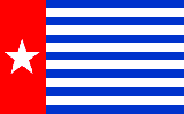Quakes were felt as far away as Darwin, said Geoscience Australia seismologist Dave Jepsen, but caused no damage in Australia.
The first 7.6-magnitude quake struck at 4.43am (0643 AEDT) on Sunday on land about 135km from Manokwari, Papua, at a depth of 35km, the US Geological Survey said. It was followed by 10 aftershocks.
At least four people died in Papua, and the airport runway nearest the epicentre was cracked, President Susilo Bambang Yudhoyono told reporters. Commercial flights to the area were cancelled.
"I've instructed emergency steps be taken to help our brothers and to restore power and other vital utilities," he said without commenting on how widespread the damage might be.
Among the dead was a 10-year-old girl whose head was crushed, said local hospital director Hengky Tewu.
"We have our ambulances picking up two more," he said. Another 19 patients at the hospital were treated for broken bones, cuts, crushed fingers and other injuries.
Papua police chief Major General Bagus Ekodanto said he received reports that a hotel and rice warehouse had been "destroyed," but he did not know if anyone had died. A search for possible victims was under way.
Several storeys of the Mutiara Hotel in the main city Manokwari collapsed, said Ina, a nurse at a navy hospital treating 20 quake patients. Like many Indonesians she goes by a single name.
Electricity was cut off and people in the coastal city of 167,000 fled their homes in the dark fearing a tsunami, said Hasim Rumatiga, a local health official. The Indonesian Meteorology and Seismology Agency issued a tsunami alert, but it was revoked within an hour after it was determined the epicentre of the main quake was on land.
Japan's Meteorological Agency said tsunamis of 10 to 40 centimetres in height splashed ashore in towns along the coast. It also warned that bigger tsunamis were possible later.
The damage in Indonesia was still be being assessed.
"My son's head was wounded when a cabinet fell on him," said Ferry Dau, a father of two who said the walls in his house were cracked. "It was very strong and scary. The power and phones went dead after the utility lines fell down."
Rahmat Priyono, a supervisor at the National Earthquake Centre, said there was no immediate information on casualties or damage. "But since the epicentres were on land, they have a potential to cause significant damage."
Quakes centred onshore pose little tsunami threat to Indonesia itself, but those close to the coast can still churn up large waves emanating out to other countries like Japan.
Relief agency World Vision Indonesia was flying in 2,000 emergency provision kits, including canned food, blankets and basic medical supplies, said spokeswoman Katarina Hardono.
Papua is the Indonesian portion of New Guinea island, located about 2,955km east of the capital Jakarta. It is among the nation's least developed areas, and a low-level insurgency has simmered in the resource-rich region for years. It is off limits to foreign reporters.
Indonesia straddles a chain of fault lines and volcanoes known as the Pacific "Ring of Fire" and is prone to seismic activity. A huge quake off western Indonesia caused the 2004 Indian Ocean tsunami that killed about 230,000 people, more than half of them on the western Indonesian island of Sumatra.
© 2009 AFP
